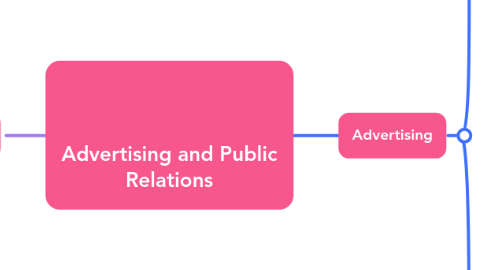
1. Public Relations
1.1. building good relations with the company’s various publics by obtaining favorable publicity, building up a good corporate image, and handling or heading off unfavorable rumors, stories, and events.
1.2. used to promote product, people, ideas, and activities.
1.3. Public relations department functions
1.3.1. Press relations or press agency
1.3.1.1. the creation
1.3.1.2. placing of newsworthy information
1.3.2. Product publicity
1.3.2.1. publicizing specific products.
1.3.3. Public affairs
1.3.3.1. building national or local community relations.
1.3.3.2. maintaining national or local community relations.
1.3.4. Lobbying
1.3.4.1. building legislators and government officials
1.3.4.2. maintaining relations with legislators and government officials
1.3.5. Investor relations
1.3.5.1. maintaining relationships with shareholders and others in the financial community.
1.3.6. Development
1.3.6.1. public relations with donors or members of nonprofit organizations
1.4. The Role and Impact of Public Relations
1.4.1. Lower cost than advertising
1.4.2. Stronger impact on public awareness than advertising
1.5. Major Public Relations Tools
1.5.1. News
1.5.2. Speeches
1.5.3. Special events
1.5.4. Written materials
1.5.5. Audiovisual materials
1.5.6. Corporate identity materials
1.5.7. Public service activities
1.5.8. Buzz marketing
1.5.9. Social networking
1.5.10. Mobile tour marketing
1.5.11. Internet
2. Advertising
2.1. Developing Advertising Programs
2.1.1. Setting advertising objectives
2.1.1.1. Informative advertising
2.1.1.2. Comparative advertising
2.1.1.3. Persuasive advertising
2.1.1.4. Reminder advertising
2.1.2. Setting advertising budget
2.1.2.1. Product life-cycle stage
2.1.2.1.1. New products require larger budgets
2.1.2.1.2. Mature brands require lower budgets
2.1.2.2. Market share
2.1.2.2.1. Building or taking market share requires larger budgets.
2.1.2.2.2. Markets with heavy competition or high advertising clutter require larger budgets.
2.1.2.2.3. Undifferentiated brands require larger budgets.
2.1.3. Developing advertising strategy
2.1.3.1. Creating the advertising message
2.1.3.1.1. Gain attention.
2.1.3.1.2. Communicate well.
2.1.3.1.3. Steps in creating effective advertising messages
2.1.3.2. Selecting the advertising media
2.1.3.2.1. Deciding on reach-frequency-impact
2.1.3.2.2. Selecting media vehicles
2.1.3.2.3. Deciding on media timing
2.1.4. Evaluating advertising campaigns
2.1.4.1. Communication effects
2.1.4.2. Sales and profit needs
2.2. Other Advertising Considerations
2.2.1. Organizing for advertising
2.2.1.1. A salesperson in smaller companies.
2.2.1.2. Advertising departments and outside agencies in larger companies
2.2.2. Advertising agencies
2.2.2.1. Employ specialists
2.2.2.2. Provide an outside view to problem-solving
2.2.3. International advertising decisions
2.2.3.1. Standardization
2.2.3.1.1. Advantages
2.2.3.1.2. Challenges
2.2.3.2. Localization
